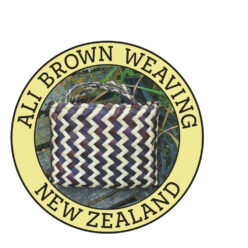30 May 2018
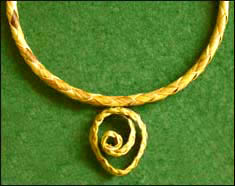 Crafting personal jewellery from natural objects is a universal and ancient pastime so it’s not surprising that people who work with New Zealand flax, harakeke, make jewellery as well as baskets, hats and other larger items. A variety of interesting jewellery pieces can be fashioned simply by plaiting four strips of flax into either an enclosed, rounded plait or an open curved plait and then shaping the plait into a necklet, earring, brooch or bracelet. For example, the pendant illustrated on the left shows the rounded plait being used to make a necklet and the curved plait being used to make a pendant shape to hang from the necklet.
Crafting personal jewellery from natural objects is a universal and ancient pastime so it’s not surprising that people who work with New Zealand flax, harakeke, make jewellery as well as baskets, hats and other larger items. A variety of interesting jewellery pieces can be fashioned simply by plaiting four strips of flax into either an enclosed, rounded plait or an open curved plait and then shaping the plait into a necklet, earring, brooch or bracelet. For example, the pendant illustrated on the left shows the rounded plait being used to make a necklet and the curved plait being used to make a pendant shape to hang from the necklet.
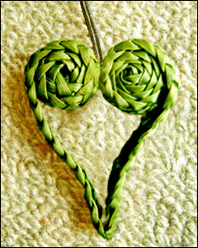 The curved version of this four-plait works well to make various shapes of pendants, like the two heart-shaped pendants illustrated here. The pendants are made by curling the plaited flax into a koru shape — a spiral shape based on the appearance of a new unfurling silver fern frond — at one end and then curling it up in the reverse direction the other end, leaving a single piece of plait in between them. The point of the heart is shaped by pinching together the single strip of flour-plait between the two koru shapes while the flax is still soft and shaping it into a curved point.
The curved version of this four-plait works well to make various shapes of pendants, like the two heart-shaped pendants illustrated here. The pendants are made by curling the plaited flax into a koru shape — a spiral shape based on the appearance of a new unfurling silver fern frond — at one end and then curling it up in the reverse direction the other end, leaving a single piece of plait in between them. The point of the heart is shaped by pinching together the single strip of flour-plait between the two koru shapes while the flax is still soft and shaping it into a curved point.
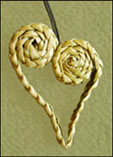 The heart shape is held together with a small stitch with thread in the centre. A waxed linen thread is added for hanging. The green pendant’s shape is a classic heart shape but I rather like the offset shape of the naturally-coloured pendant which is made by joining the two koru shapes so they are slightly offset from each other.
The heart shape is held together with a small stitch with thread in the centre. A waxed linen thread is added for hanging. The green pendant’s shape is a classic heart shape but I rather like the offset shape of the naturally-coloured pendant which is made by joining the two koru shapes so they are slightly offset from each other.
 Illustrated on the left is a variation I made of the koru pendant. This design has a small koru in the centre which is encircled with a larger single row of curved four-plait. To complete the pendant, the ends are threaded through into the plaiting of the outside plait, by threading each end twice through into the plait pattern. This secures the outer encircling plait. A waxed linen thread with a loop at one end and a paua shell button at the other end is used for hanging the pendant.
Illustrated on the left is a variation I made of the koru pendant. This design has a small koru in the centre which is encircled with a larger single row of curved four-plait. To complete the pendant, the ends are threaded through into the plaiting of the outside plait, by threading each end twice through into the plait pattern. This secures the outer encircling plait. A waxed linen thread with a loop at one end and a paua shell button at the other end is used for hanging the pendant.
 I also made a smaller version into earrings. To allow the earring to hang freely and on an angle which shows the pattern fully, the koru circlet needs a jump ring, or extra ring, between the circlet and the earring hook. Unfortunately I only made one of these earrings so have never worn this one as an earring, although I do wear the pendant regularly and have received favourable comments on it. (I must make that second earring sometime!)
I also made a smaller version into earrings. To allow the earring to hang freely and on an angle which shows the pattern fully, the koru circlet needs a jump ring, or extra ring, between the circlet and the earring hook. Unfortunately I only made one of these earrings so have never worn this one as an earring, although I do wear the pendant regularly and have received favourable comments on it. (I must make that second earring sometime!)
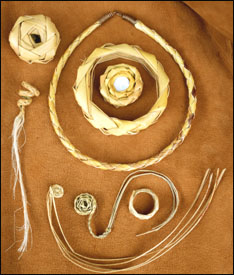 I’ve played around with a few different ideas for making jewellery with a four-plait, including enclosing a small shell or stone in the centre of the koru. The curved four-plait makes a nicely rounded bracelet, or a ring. A smaller version of the bracelet could be used for napkin rings, or with a few more layers, a toggle to hold a scarf if the hole in the centre is a bit larger than the one illustrated here. I like long tails on the koru but haven’t yet found any practical jewellery use for this style, although I can see it being used in other ways. Do you have any more ideas for koru jewellery? Or other sorts of woven jewellery? I’d love to see them.
I’ve played around with a few different ideas for making jewellery with a four-plait, including enclosing a small shell or stone in the centre of the koru. The curved four-plait makes a nicely rounded bracelet, or a ring. A smaller version of the bracelet could be used for napkin rings, or with a few more layers, a toggle to hold a scarf if the hole in the centre is a bit larger than the one illustrated here. I like long tails on the koru but haven’t yet found any practical jewellery use for this style, although I can see it being used in other ways. Do you have any more ideas for koru jewellery? Or other sorts of woven jewellery? I’d love to see them.
I’ve written instructions on how to make the curved four-plait here and there are instructions for the rounded four-plait cord on this blog post.
© Ali Brown 2018.
Scroll down to leave a new comment or view recent comments.
Also, check out earlier comments received on this blog post when it was hosted on my original website.
